Corals are highly rewarding, especially in saltwater tanks. Not only do they increase the beauty of the aquarium, but they also serve as a food source for herbivores, carnivores, and planktivores fish. But sometimes, you must frag them to prevent them from taking over other corals. And to do that, you must know how to frag coral.
To frag corals, first pull out the coral you want to frag with its rocks or stone and use a pair of scissors to cut fragments of it. Then place the frags in a water bowl filled with tank water. Take out the frags, glue them to the frag plug, or attach them to live rocks using rubber bands and set them in their new location.
Fragging coral is not as challenging as many people might think. But people often fail in this task due to the lack of proper guidelines, which is why I prepared this article. So if you want to learn about fragging corals and some essential tricks and tips, I urge you to read the full article.
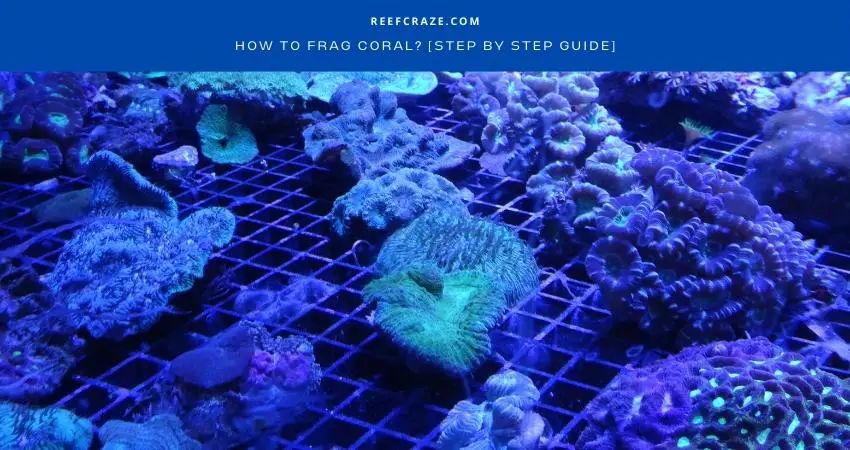
What Are Coral Frags? How Does It Work?
Before I give you the basic definition, here is a bit from my own experience. I always heard the word “coral frag” whenever I visited my pro aquarist friend and other hobbyists. As I was a beginner at the time, I had very little idea and interest in it.
And then, one day, I visited a fish/aquarium retailer shop and found coral frag on sale. That is how I came to learn about fragging and mounting coral.
It turned out that the word frag is the short form for coral fragment or fragmentation. They really are pieces or fragments of an original and larger coral colony. Until they grow large enough, they are referred to as frag because of their smaller size.
Let me also mention the frag plug, where the coral is mounted to grow. But you can use your aquarium rubbles instead of plugs to mount to frag.
Coral frags are very popular among aquarists, beginners, and pros because they are not expensive as a fully-grown coral colony. Besides, owning a small frag and then witnessing it grow over time is satisfying for many owners.
How Coral Fragging Works?
Before you learn how to frag coral, it is essential to know why you do it and if there is no harm in doing so. Besides, fragging corals is more than planting them in a different area.
Coral fragging is basically breaking, cutting, or subdividing a fully-grown coral colony. Breaking them apart or cutting fragments might seem like a cruel thing to do. But you should know that corals are naturally self-healers. They can survive even when being cut and taken apart from the original colony.
You can imagine it with the rough situations they go through in the sea, such as strong currents and hurricanes. Corals break apart because of natural reasons all the time, yet they establish new colonies in their new locations. Coral frag is similar, but the entire situation occurs in your saltwater aquarium.
![How To Frag Coral? [Step by Step Guide] 1](https://reefcraze.com/wp-content/uploads/2022/08/How-Coral-Fragging-Works.jpg)
They heal themselves gradually in their newly planted environment and grow and establish their new colony. This specialty of corals has always been present in their DNA, making them suitable for fragging or laboratory experiments. And since corals are capable of healing, establishing, and reproducing on their own, fragmenting them actually helps them grow in different areas and expand more.
After fragging the corals, you plant them on what we call the “frag plug”. It is a surface that offers stability to plant the frags. And, over time, the coral adheres to the provided surface. You can use live rock as frag plants to offer more stability.
And the rest will be done by the coral themselves as they do not need any special treatment to grow and breed. You can keep them in the same light, flow, and water condition as you regularly maintain for your fish tank.
How To Frag Coral: A Step-By-Step Guide
![How To Frag Coral? [Step by Step Guide] 2](https://reefcraze.com/wp-content/uploads/2022/12/Frag-Tank.jpg)
If you have a full-grown coral colony in your tank, you would want to frag them before they take over more of their surroundings. Besides, fish tanks have limited space for everything, making it essential to remove portions of growing substrates and plant them somewhere else if possible.
You may also want to frag coral to grow them in another part of your aquarium, or maybe one of your friends or acquaintances has asked for the coral frag to grow them in their tanks. Nevertheless, be prepared with some essential tools you will need for the project before you set up your workplace.
Time Required 1 hour
Preparations Before Fragging
You need to do some prep work before you frag corals. First, prepare the workplace near your aquarium so that all materials will be easy to reach and use. And since you will be handling wet items, it is best to spread a towel on the work surface to prevent unexpected occurrences.
Talking about unexpected occurrences, you have to work using sharp and brand-new razor blades. So it is essential to keep some band-aids close to your hands in case you accidentally cut yourself. Trust me, even the professionals keep these ready because you never know what to expect. Now, let’s go frag some corals.
Pull Out The Rocks With Corals
Since the coral is inside the tank, you will not want to work on fragging it while keeping your hands under tank water. Yet, many aquarists choose to do so, which also increases fragging hassle when they follow the latter steps.
Fragging corals when it is under tank water is also hectic because it will spill water all over. It also stresses the fish inside your tank and messes up water movement.
So it is best to pull out the coral with the stone or rocks it is attached to. Make sure to wear protective gloves and glasses when handling the corals. And then, place the coral and the rock on a towel to ensure you don’t get water everywhere.
Slice Off The Corals
Now take a pair of scissors and cut the soft portions of the coral. You can cut from any part, but the soft ones are healthier and recover quickly from fragging. Cut as many frags as you need to locate them to the new location. It is best if you cut from the stalk, leaving the part that is stuck to the rock or stone.
Put The Frags In A Bowl Of Water
Take a bowl or container and fill it with your tank water. Then place the coral frags into the bowl to keep them soaked. During this time, you will see that the fresh-cut areas have brown or white things oozing out or white things hanging out. It is nothing you should worry about as it is the natural response of the frags after they are cut.
Dump The Water
Once the water heals the fresh injuries of the coral frags, dump the water. Do not worry about the “injury” part, as corals do not feel hurt like live animals.
Attach The Rocks And Frags/Glue To The Frag Plugs
Now, use the rubber bands to tie the coral frags to the rocks. You can take out pieces of live rocks from the aquarium to attach the frags.
Some people use toothpicks to ensure the frags are secured tightly to the rocks or plus, but that is not always necessary.
Another way to relocate these frags is mounting them in frag plugs. You can use reef glue to attach the frags on top of the plugs and stick them between reef rocks or the bottom.
Place The Frags In The New Location
Finally, place the coral frags in their new location. Coral frags do not need a different water condition or environment, making it easier for you to let them be. Once the frags settle or get attached to the rocks and start establishing, you can take off the rubber bands.
Additional Read: How to frag zoas
Which Coral Is Best For Fragging? – Choose The Right Species
Slow down a little bit before you start fragging any coral. Well, technically speaking, you CAN frag ANY coral because they work in pretty much the same way. However, if you are a starter, you will not want to go for something that has complexity.
It means you need to be picky with the coral species. Doing that helps you work with more precision without going through much hassle. So, which are the best coral species for fragging?
Mushroom Corals
![How To Frag Coral? [Step by Step Guide] 3](https://reefcraze.com/wp-content/uploads/2022/08/Mushroom-Coral.jpg)
Mushroom corals are the first and best choice for beginners. These hardiest yet soft corals grow rapidly like mushrooms with a base and mushroom-like top. The base keeps growing until they become a full-size coral. Mushroom corals require frequent fragging because of their rapid growth and tendency to take over other corals faster. Fragging mushroom corals require the simplest tasks and are less time-consuming.
Candy Cane Corals
![How To Frag Coral? [Step by Step Guide] 4](https://reefcraze.com/wp-content/uploads/2022/08/Candy-Cane-Corals.jpg)
If you need a second choice for fragging coral as a beginner, candy cane coral is also an excellent option. They are very peaceful and live in harmony with other reef residents. These corals have the perfect anatomy for beginners to frag them with ease. While you can simply separate the fluffy polyp with your hands, I advise using a sharp cutter or pliers. And make sure not to go for the base when fragging them.
Toadstool Leather Corals
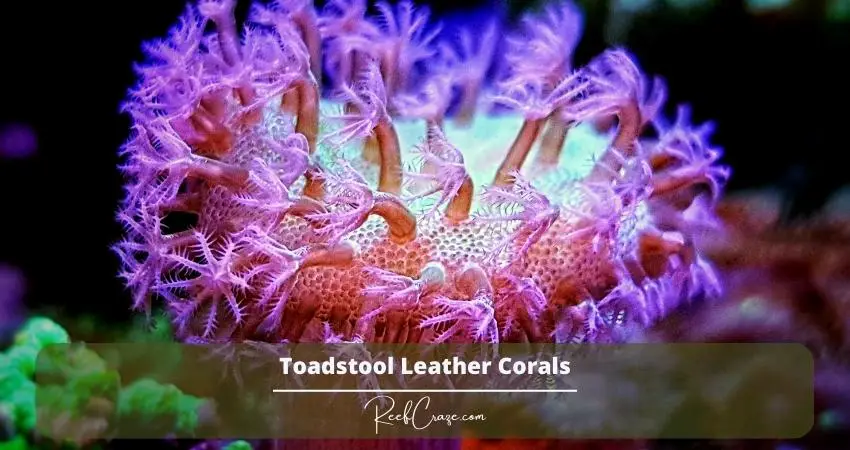
Toadstool leather corals are among the commonly found species and look mesmerizing with their swaying movement in the reef tank. If you have clown fish in your tank, you will notice them getting comfier in these corals. While fragging toadstool leather corals are pretty straightforward, it is best if you use a pair of scissors to frag them. But make sure to wash everything well before placing them into the tank because they release a toxic substance from the cut-out areas.
Acropora
![How To Frag Coral? [Step by Step Guide] 5](https://reefcraze.com/wp-content/uploads/2022/08/Acropora.jpg)
Acropora basically claims about one-third of the coral reef environment. They are SPS or small polyp stony and grow well in favorable water conditions. Acropora appears vivid under moderate light, but intense light can cause discoloration. While they are not intensely fast-grower, Acropora often requires fragging for trading or growing in other locations. And instead of using sharp blades or scissors, you will need pliers to frag them.
Green Star Polyps
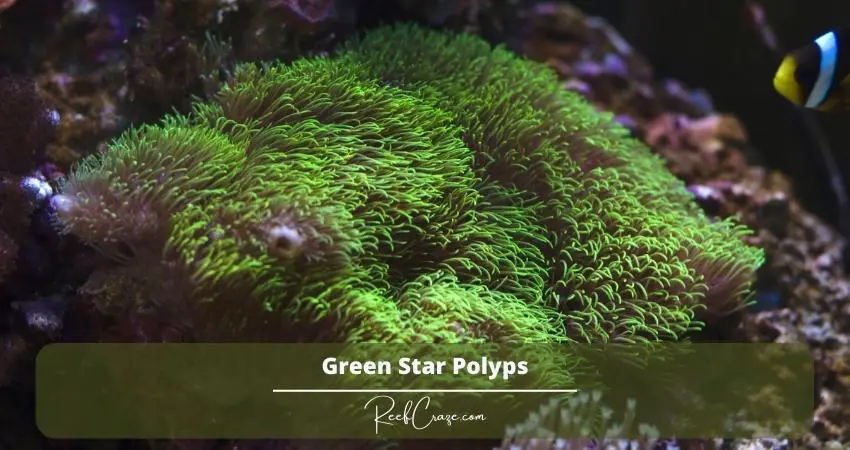
GSP or green star polyps are not something you will want in your tank unless you like fragging often or want a tank full of them. They grow so rapidly that it is challenging to maintain them without fragging the excessively growing parts. Since they grow like weeds, they start to take over tank pipes, walls, and pumps in a blink of an eye. Fragging these corals is necessary as they grow beyond the rocks. You would want to take parts of them off the rocks and other places more often than you think.
Torch Corals
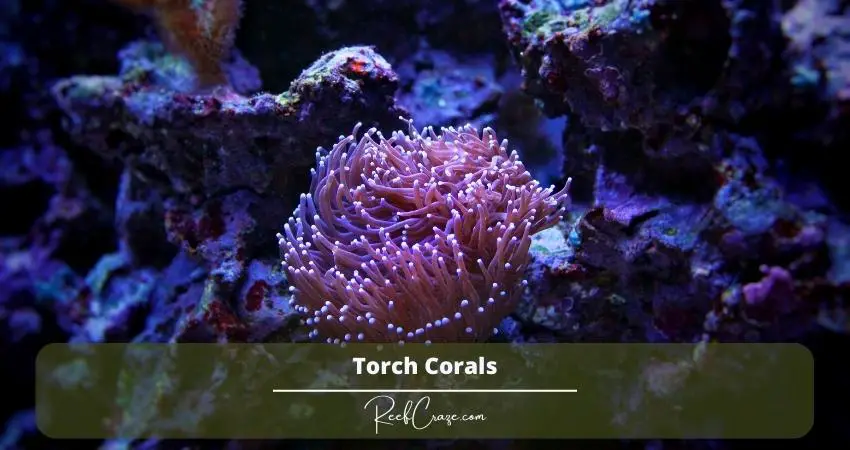
Torch corals look like torch heads facing the tank top. These corals have a beautiful movement in moderate water flow and are not aggressive like most others. On the contrary, it is essential to ensure the tank fish do not attack them after placing them in the tank. Fragging them requires a bandsaw because they do well when you ensure a clean cut. And make sure to wash them well as torch corals release toxic substances when fragged.
Plate Coral
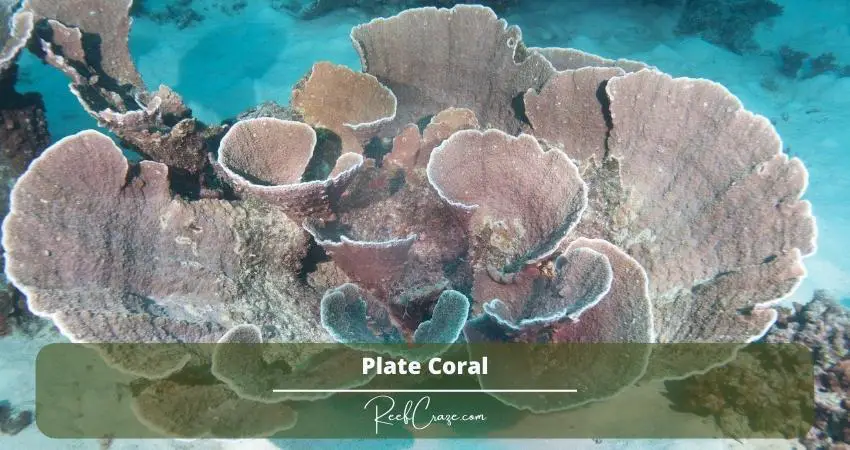
The unique coral species I have on this list is the plate coral. It has this funny name because the coral does look like an upside-down plate or saucer. And these corals have a month right in the middle. However, cutting them with a manual saw will not work. You will need a band saw to cut them like a pizza. And make sure each frag piece has a part of the coral’s eye.
When You Should Not Frag Corals?
Coral fragging is not always mandatory. People frag corals when they want to grow them in other areas, when they start taking over other coral colonies, or when someone wants to take some coral frags for themselves. And some aquarists choose not to frag corals because they do not see it as necessary. So, when should you not frag coral?
1. If You Want To Fill Your Tank With It
As I mentioned, not all aquarists have the same goal when it comes to reef tank corals. Some prefer to grow a full tank of them without worrying about fragging them. So if you plan to grow diverse species of corals and have a full tank of them, you do not need to frag them. You just provide them with what they need and leave them alone.
2. If The Coral Has A Slow Growth
Coral’s growth level depends on various factors, such as the species, water condition, environment, and what they eat. While some corals grow at a faster speed, others grow really slow. And in case you have such slow-growing corals, you might want to avoid fragging them.
3. If The Coral Is New
You should never frag new corals. Corals take some time to settle in a new environment and establish themselves. Give them a couple of months to get used to their inhabitants and then frag them based on their conditions.
Tips To Frag Corals
If you are fragging corals for the first time, here are some tips you should know before you start.
- Always wear protective gloves and glasses when fragging corals, as many of them release toxic substances.
- If you think handling the frags will be rough, you can wear protective clothing and tie your hair if they are long.
- Metal fragging tools must be washed with RO water if you do not want them to get rusty.
- Focus on how you cut them. While cutting into random shapes is okay, you can attach them to rocks, stones, or plugs better if you cut them into a good shape.
- Always make sure to dip freshly-fragged corals in a bowl of tank water before you attach them to the plus or stones. It gives the coral enough time to recover well from the injury.
Benefits Of Coral And Coral Frag For Marine Life
Corals are more like colonial organisms. They are not just one but many identical and individual polyps together. On the other hand, coral frags are fragments or pieces of grown coral colonies.
Corals are seen in a large number in the marine environment. While they claim only 1% of the ocean’s surface, they provide food, shelter, and breeding ground for around 25% of marine life. They have other benefits for saltwater aquariums and their inhabitants.
Corals are highly beneficial to the marine ecosystem, making them more valuable. It is a known fact that corals can support more marine species in a single unit than most other aquatic environments. Because of this diversity, coral reefs are called the Rainforest of the Sea.
Many fish and other sea creatures use coral and frags as a place to hide or seek food. Corals offer food resources for all kinds of fishes, many of which rely entirely on coral and coral frags for survival. For example, fishes like parrotfish eat microalgae from coral for their development, and their beak-like mouth finds it easier to devour them.
On the other hand, surgeonfish, who have smaller mouths, can also feast on microalgae from coral frags without any problem. At the same time, corals are jawfish’s favorite territory as they prey on small fishes living around the corals.
Many marine fishes have camouflage based on their surroundings to hide and protect themselves from predators. Coral and coral frags are an excellent option for them. It also helps them take their prey by surprise when hunting for food.
Coral frags are visually stunning. So are the fishes that inhabit them and reproduce. It helps enhance the appearance of the aquarium and make it attractive to people. And that is one of the many reasons why aquarists prefer having coral frags in their fish tanks.
Frequently Asked Questions
Does fragging hurt coral?
No, fragging does not hurt coral or kill them. However, the coral frags need some time to recover and heal after fragging. While healthy corals recover pretty fast, weaker ones take some time.
Can you frag any coral?
The best types of coral for fragging are the soft ones. They are healthier and require less time to recover after fragging. And since soft corals grow well and quickly, they need fragging before taking over other coral colonies.
How long does it take for coral frags to grow?
Coral frag’s growth rate depends mainly on its species. And they do not grow faster in a reef tank like they usually would. But you can expect fragged corals to establish themselves in a week.
Do you need live rocks in a frag tank?
Live rocks are the best way to provide coral frags with a medium for bacteria. Besides, they help stabilize the tank’s water parameters. And if you do not have live rocks in a frag tank, you will have to clean the tank more often.
Do frag tanks need fish?
While it is not mandatory to have fish in a frag tank, having them can help balance nitrates and phosphates. But if you do not want to keep fish in the frag tank, you must feed the corals with nitrate and phosphates.
EndNote
Learning how to frag coral is fun for reef tank owners and hobbyists. However, as a beginner, knowing what type of coral would make your job easier and how you can frag them well is essential.
Remember that fragging is not essential but needs to be done in some cases. Also, it can help you prevent over-colonization of corals and spread different species by sharing them with other aquarists.
